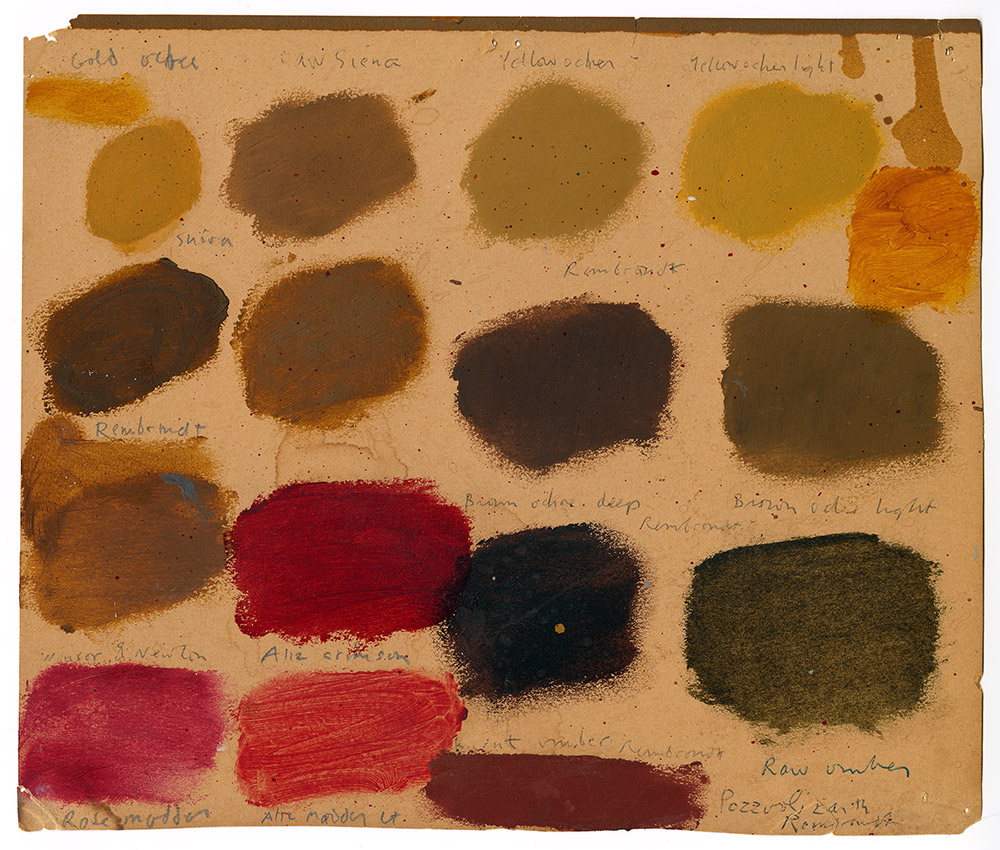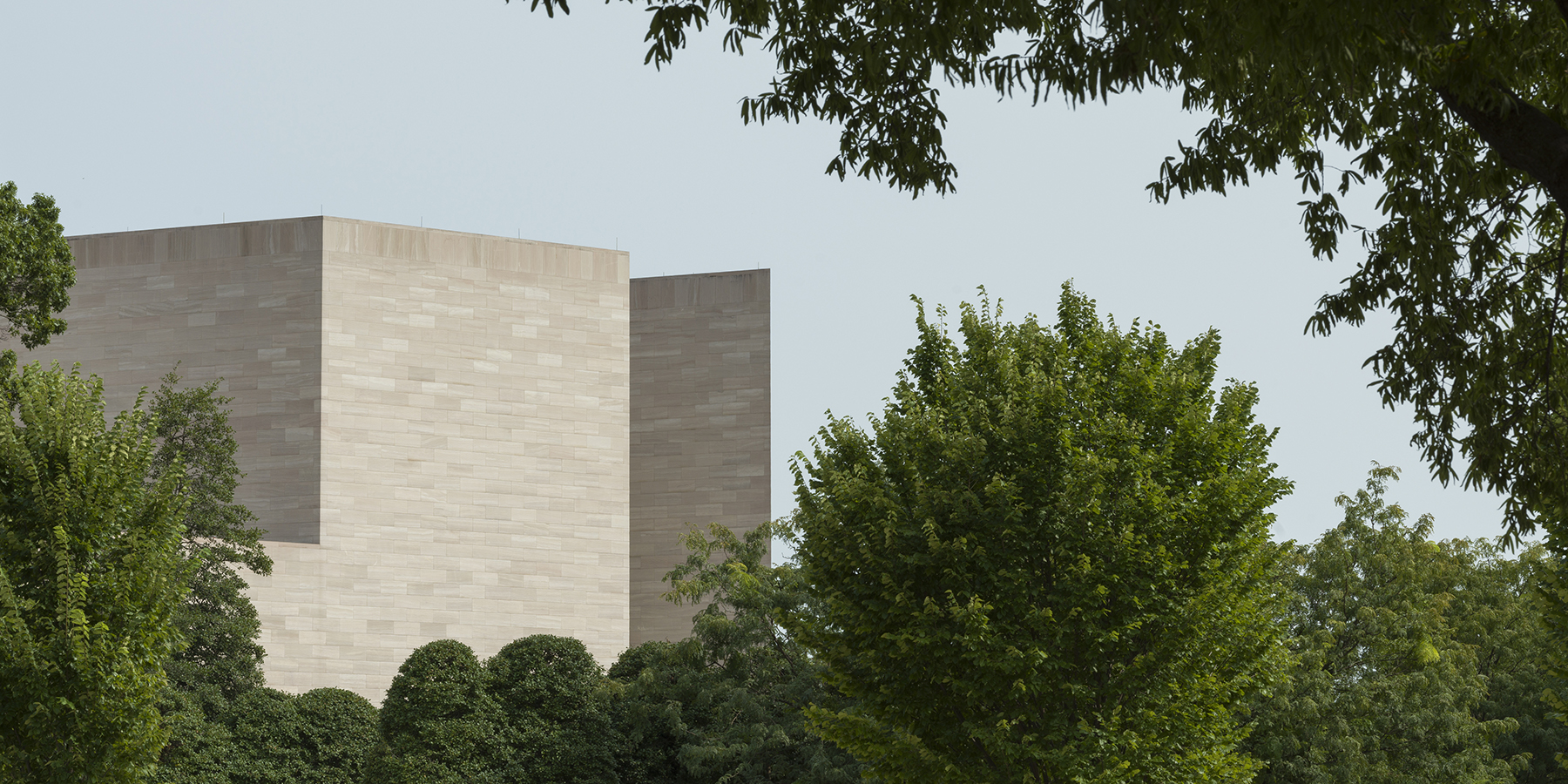Molly Warnock
The Subject of Painting: James Bishop and Tel Quel

James Bishop, Annotated color swatches relating to the brown paintings, early 1970s, personal collection. Author photograph; © James Bishop Estate
During my fellowship, I continued work on my current book project. This manuscript has a double aim: first and foremost, it seeks to provide a central reference on the work of a historically underappreciated figure of significant achievement. James Bishop (1927–2021) studied painting at Black Mountain College and Washington University in Saint Louis and art history at Columbia University before traveling to Europe in 1957 and settling in France the following year. Throughout his life, he identified primarily as a disciple of abstract expressionism, with an especially strong affinity for the work of Robert Motherwell and, later, Barnett Newman, Mark Rothko, and Ad Reinhardt. His work nonetheless reveals a much broader engagement with art history, from Italian Renaissance painting through American postminimalism. “The Subject of Painting: James Bishop and Tel Quel” will be the first scholarly monograph to address all stages of the painter’s career, spanning 60 years in total, and provide intensive, firsthand analyses of the artist’s uniquely compelling body of abstract compositions on canvas and paper.
At the same time, this book aspires to a larger rethinking of the relations among artistic practice, philosophy, and critical thought in the decades since World War II, with an eye to the continued—if repeatedly contested—pertinence of painting in particular. For a sustained period following Bishop’s arrival in Europe, his practice constituted a central reference for the group of artists and writers associated with the journal Tel Quel and its satellite, Peinture, cahiers théoriques. Published in Paris between 1960 and 1982, Tel Quel is well-known in the United States as a major vehicle for the emergence of “French theory,” a distinction secured by the journal’s early support for and publication of writings by Roland Barthes, Jacques Derrida, and Michel Foucault, among others—as by the presence, from 1970 forward, of Julia Kristeva on the editorial committee. Yet, until now, little attention has been paid to the journal’s enduring engagement with aspects of contemporary visual production. Bishop’s work offers a privileged lens through which to explore this investment.
Throughout my residency period, I focused on the second of what will be three long chapters devoted to a distinct subset of Bishop’s paintings. During the early seventies, the artist completed a suite of roughly 20 abstract canvases that turn entirely upon various browns, as manifest either in allover fields of subtly variegated paint or as relegated to horizontal or vertical rectangles set against equal or slightly larger expanses of the primed but non-painted white support. Marrying a suggestive bodily palette to impersonal geometric scaffolding, and clearly attuned to the standing human form (each is roughly 77 inches square), these paintings eschew clear-cut figure–ground relations in favor of the visually unstable interplay between adjacent forms. Color seeps across seamlike divisions that might equally appear to be lines of congress.
These paintings exerted a powerful gravitational pull on the Tel Quel group, garnering important essays from editors Philippe Sollers and Marcelin Pleynet, among other writers. Attending in detail to this reception, but also going beyond its explicit emphases, my own account focuses on the canvases’ complex relationship to prior traditions of brown ground painting and, more specifically, to the highly suggestive account of Rembrandt van Rijn’s enterprise put forward in the late fifties and sixties by French writer Jean Genet. (The key text here is Genet’s “What Remains of a Rembrandt Torn into Little Squares All the Same Size and Shot Down the Toilet,” an essay famously published in Tel Quel in the spring of 1967 but known to Bishop well before.) Special attention is paid there to Genet’s provocative assertion that Rembrandt’s late portraits “refer to no identifiable person”: that they show us the deep equivalence of all men, a commonality rooted in flesh. Torn between a certain aspiration to neutrality and the claims of the erotic, no less powerful, Bishop’s extraordinarily subtle compositions emerge as a profound meditation on the place—or non-place—of the body in contemporary abstraction.
Writing this summary, in the early days of March 2021, is bittersweet. On February 17, shortly after the end of my fellowship, Bishop died following a sudden stroke. He was 93 years old. He was in high spirits several days before, when we spoke by telephone for the last time. He knew my time at the Center had been fruitful and was pleased to know the book manuscript was progressing. Needless to say, my work continues with a renewed sense of urgency.
Johns Hopkins University
Ailsa Mellon Bruce Visiting Senior Fellow, winter 2020–2021
During the 2021–2022 academic year, Molly Warnock will be a NOMIS Fellow at eikones— Zentrum für die Theorie und Geschichte des Bildes at Universität Basel.
